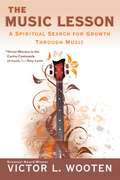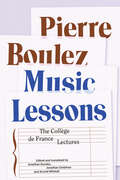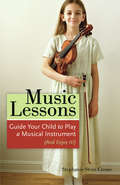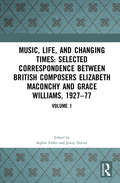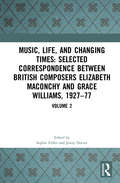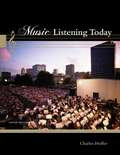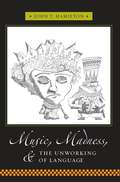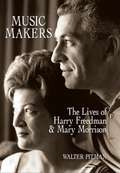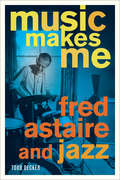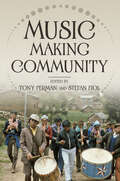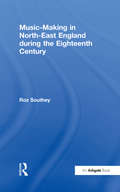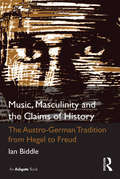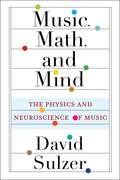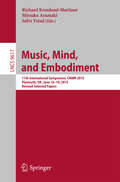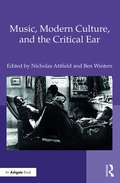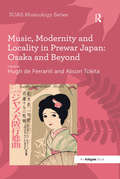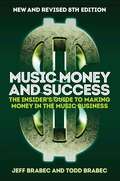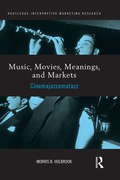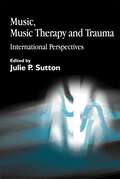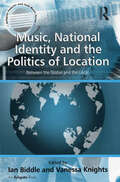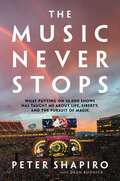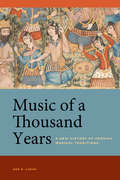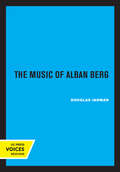- Table View
- List View
The Music Lesson: A Spiritual Search for Growth Through Music
by Victor L. WootenFrom Grammy-winning musical icon and legendary bassist Victor L. Wooten comes The Music Lesson, the story of a struggling young musician who wanted music to be his life, and who wanted his life to be great. Then, from nowhere it seemed, a teacher arrived. Part musical genius, part philosopher, part eccentric wise man, the teacher would guide the young musician on a spiritual journey, and teach him that the gifts we get from music mirror those from life, and every movement, phrase, and chord has its own meaning...All you have to do is find the song inside.
Music Lessons: The Collège de France Lectures
by Pierre BoulezMusic Lessons marks the first publication in English of a groundbreaking group of writings by French composer Pierre Boulez, his yearly lectures prepared for the Collège de France between 1976 and 1995. The lectures presented here offer a sustained intellectual engagement with themes of creativity in music by a widely influential cultural figure, who has long been central to the conversation around contemporary music. In his essays Boulez explores, among other topics, the process through which a musical idea is realized in a full-fledged composition, the complementary roles of craft and inspiration, and the degree to which the memory of other musical works can influence and change the act of creation. Boulez also gives a penetrating account of problems in classical music that are still present today, such as the often crippling conservatism of established musical institutions. Woven into the discussion are stories of his own compositions and those of fellow composers whose work he championed, as both a critic and conductor: from Stravinsky to Stockhausen and Varèse, from Bartók to Berg, Debussy to Mahler and Wagner, and all the way back to Bach. Including a foreword by famed semiologist Jean-Jacques Nattiez, who was for years a close collaborator and friend of the composer, this edition is also enriched by an illuminating preface by Jonathan Goldman. With a masterful translation retaining Boulez’s fierce convictions, cutting opinions, and signature wit, Music Lessons will be an essential and entertaining volume.
Music Lessons: Guide Your Child to Play a Musical Instrument (and Enjoy It!)
by Stephanie Stein CreaseProviding guidance for parents who want their children to enjoy learning to play a musical instrument, this resource teaches parents the best ways to encourage children's musical talents. Key guidance is provided for the trickiest hurdles of all: helping children learn how to practice and navigating their impulse to quit by encouraging them to take pride in their progress despite the frustrations of the learning process. Commonly taught methods--including Suzuki, Kodaly, Dalcroze training, and the Orff approach--and instrument selection are discussed in detail, as are tips for choosing the right teacher. Up-to-date resources and references for youth orchestras, national and regional organizations, outreach programs, and school advocacy organizations, and supplementary materials for various ages and stages of ability, are provided.
Music, Life and Changing Times: Volume 1 (Music, Life and Changing Times)
by Jenny Doctor Sophie FullerAt this book's core is a critical edition of letters exchanged over 50 years between Anglo-Irish composer Elizabeth Maconchy (1907-1994) and the Welsh composer Grace Williams (1906-1977). These two innovative and talented women are highly regarded for their music, their professional activities, and their roles in British musical life. The edition comprises around 353 letters from 1927 to 1977, none of which have been published before, along with scholarly introductions and contextualisation. Interwoven commentaries, in tandem with carefully constructed appendices, frame the letter texts. Moreover, the commentaries and introductory essays highlight and track the development of important themes and issues that characterise the study of twentieth-century British music today. This edition presents a dialogue, through both sides of a unique correspondence, offering an alternative commentary on musical and cultural developments of this period.
Music, Life and Changing Times: Volume 2 (Music, Life and Changing Times)
by Jenny Doctor Sophie FullerAt this book's core is a critical edition of letters exchanged over 50 years between Anglo-Irish composer Elizabeth Maconchy (1907-1994) and the Welsh composer Grace Williams (1906-1977). These two innovative and talented women are highly regarded for their music, their professional activities and their roles in British musical life. The edition comprises around 200 letters from 1927 to 1977, none of which have been published before, along with scholarly introductions and contextualizations. Interwoven commentaries, in tandem with carefully constructed appendices, frame the letter texts. Moreover, the commentaries and introductory essays highlight and track the development of important themes and issues that characterize the study of twentieth-century British music today. This edition presents a dialogue, through both sides of a unique correspondence, offering an alternative commentary on musical and cultural developments of this period.
Music Listening Today
by Charles HofferCharles Hoffer's best-selling MUSIC LISTENING TODAY is a complete course solution that develops student's listening skills while teaching them to appreciate the different styles, forms, and genres of music. The text provides dozens of familiar and lesser-known musical selections, all carefully chosen for their ability to get students interested in listening to all kinds of music.
Music, Madness, and the Unworking of Language (Columbia Themes in Philosophy, Social Criticism, and the Arts)
by John HamiltonIn the romantic tradition, music is consistently associated with madness, either as cause or cure. Writers as diverse as Kleist, Hoffmann, and Nietzsche articulated this theme, which in fact reaches back to classical antiquity and continues to resonate in the modern imagination. What John Hamilton investigates in this study is the way literary, philosophical, and psychological treatments of music and madness challenge the limits of representation and thereby create a crisis of language. Special focus is given to the decidedly autobiographical impulse of the late eighteenth and early nineteenth centuries, where musical experience and mental disturbance disrupt the expression of referential thought, illuminating the irreducible aspects of the self before language can work them back into a discursive system. The study begins in the 1750s with Diderot's Neveu de Rameau, and situates that text in relation to Rousseau's reflections on the voice and the burgeoning discipline of musical aesthetics. Upon tracing the linkage of music and madness that courses through the work of Herder, Hegel, Wackenroder, and Kleist, Hamilton turns his attention to E. T. A. Hoffmann, whose writings of the first decades of the nineteenth century accumulate and qualify the preceding tradition. Throughout, Hamilton considers the particular representations that link music and madness, investigating the underlying motives, preconceptions, and ideological premises that facilitate the association of these two experiences. The gap between sensation and its verbal representation proved especially problematic for romantic writers concerned with the ineffability of selfhood. The author who chose to represent himself necessarily faced problems of language, which invariably compromised the uniqueness that the author wished to express. Music and madness, therefore, unworked the generalizing functions of language and marked a critical limit to linguistic capabilities. While the various conflicts among music, madness, and language questioned the viability of signification, they also raised the possibility of producing meaning beyond significance.
Music Makers: The Lives of Harry Freedman and Mary Morrison
by Walter PitmanMusic Makers examines and celebrates the extraordinary lives of composer Harry Freedman and his partner, soloist Mary Morrison.Harry, with roots in jazz and popular music, was a member of the Toronto Symphony Orchestra for 25 years. Canada’s Composer of the Year in 1979, he has written an enormous repertoire that celebrates Canada and is sung and played around the world.After a stellar career in Canada as a popular singer and opera diva, Mary became an esteemed exponent of Canadian vocal works. She was a prestigious mentor and teacher of young Canadians now appearing on famous opera stages worldwide. She received the League of Composers’ Music Citation in 1968 and won Canada’s major award as Opera Educator in 2002.
Music Makes Me: Fred Astaire and Jazz
by Todd DeckerFred Astaire: one of the great jazz artists of the twentieth century? Astaire is best known for his brilliant dancing in the movie musicals of the 1930s, but in Music Makes Me, Todd Decker argues that Astaire's work as a dancer and choreographer --particularly in the realm of tap dancing--made a significant contribution to the art of jazz. Decker examines the full range of Astaire's work in filmed and recorded media, from a 1926 recording with George Gershwin to his 1970 blues stylings on television, and analyzes Astaire's creative relationships with the greats, including George and Ira Gershwin, Irving Berlin, Jerome Kern, and Johnny Mercer. He also highlights Astaire's collaborations with African American musicians and his work with lesser known professionals--arrangers, musicians, dance directors, and performers.
Music Making Community
by Bruno Nettl Joanna Bosse Stefan Fiol Stephen Blum Veit Erlmann Eduardo Herrera Ioannis Tsekouras Donna A Buchanan Thomas Solomon Sylvia Bruinders David A McDonald Rick DejaMaking music offers enormous possibilities--and faces significant limitations--in its power to generate belonging and advance social justice. Tony Perman and Stefan Fiol edit essays focused on the forms of interplay between music-making and community-making as mutually creative processes. Contributors in the first section look at cases where music arrived in settings with little or no sense of community and formed social bonds that lasted beyond its departure. In the sections that follow, the essayists turn to stable communities that used musical forms to address social needs and both forged new social groups and, in some cases, splintered established communities. By centering the value of difference in productive feedback dynamics of music and community while asserting the need for mutual moral indebtedness, they foreground music’s potential to transform community for the better. Contributors: Stephen Blum, Joanna Bosse, Sylvia Bruinders, Donna A. Buchanan, Rick Deja, Veit Erlmann, Stefan Fiol, Eduardo Herrera, David A. McDonald, Tony Perman, Thomas Solomon, and Ioannis Tsekouras
Music-Making in North-East England during the Eighteenth Century
by Roz SoutheyThe north-east of England in the eighteenth century was a region where many different kinds of musical activity thrived and where a wide range of documentation survives. Such activities included concert-giving, teaching, tuning and composition, as well as music in the theatre and in church. Dr Roz Southey examines the impulses behind such activities and the meanings that local people found inherent in them. It is evident that music could be perceived or utilized for extremely diverse purposes; as entertainment, as a learned art, as an aid to piety, as a profession, a social facilitator and a support to patriotism and nationalism. Musical societies were established throughout the century, and Southey illustrates the social make-up of the members, as well as the role of Gentlemen Amateurs in the organizing of concerts, and the connections with London and other centres. The book draws upon a rich selection of source material, including local newspapers, council and ecclesiastical records, private papers and diaries and accounts of local tradesman, as well as surviving examples of music composed in the area by Charles Avison, Thomas Ebdon and John Garth of Durham, amongst many others. Charles Avison's importance is focused upon particularly, and his Essay on Musical Expression is considered alongside other contemporary writings of lesser fame. Southey provides a fascinating insight into the type and social class of audiences and their influence on the repertoire performed. The book moves from a consideration of music being used as a 'fashion item', evidenced by the patronage of 'big name' soloists from London and abroad, to fiddlers, ballad singers, music at weddings, funerals, public celebrations, and music for marking the events of the American War of Independence and the French Revolutionary Wars. It can be seen, therefore, that the north east was an area of important musical activity, and that the music was always interwoven into the political, economic, religious and commercial fabric of eighteenth-century life.
Music, Masculinity and the Claims of History: The Austro-German Tradition from Hegel to Freud
by Ian BiddleWhat does it mean to think of Western Art music - and the Austro-German contribution to that repertory - as a tradition? How are men and masculinities implicated in the shaping of that tradition? And how is the writing of the history (or histories) of that tradition shaped by men and masculinities? This book seeks to answer these and other questions by drawing both on a wide range of German-language writings on music, sound and listening from the so-called long nineteenth century (circa 1800-1918), and a range of critical-theoretical texts from the post-war continental philosophical and psychoanalytic traditions, including Lacan, Zizek, Serres, Derrida and Kittler. The book is focussed in particular on bringing the object of historical writing itself into scrutiny by engaging in what Zizek has called a 'historicity' or a way of writing about the past that not merely acknowledges the ahistorical kernel of historical writing, but brings that kernel into the light of day, takes account of it and puts it into play. The book is thus committed to a kind of historical writing that is open-ended - though not ideologically naïve - and that does not fix or stabilize the nature of the relationship between so-called 'primary' and 'secondary' texts. The book consists of an introduction, which places the study of classical music and the Austro-German tradition within broader debates about the value of that tradition, and four extensive case studies: an analysis of the cultural-historical category of listening around 1800; a close reading of A. B. Marx's Beethoven monograph of 1859; a consideration of Heinrich Schenker's attitudes to the mob and the vernacular more broadly and an examination, through Franz Kafka, of the figure of Mahler's body.
Music, Math, and Mind: The Physics and Neuroscience of Music
by Professor David SulzerWhy does a clarinet play at lower pitches than a flute? What does it mean for sounds to be in or out of tune? How are emotions carried by music? Do other animals perceive sound like we do? How might a musician use math to come up with new ideas?This book offers a lively exploration of the mathematics, physics, and neuroscience that underlie music in a way that readers without scientific background can follow. David Sulzer, also known in the musical world as Dave Soldier, explains why the perception of music encompasses the physics of sound, the functions of the ear and deep-brain auditory pathways, and the physiology of emotion. He delves into topics such as the math by which musical scales, rhythms, tuning, and harmonies are derived, from the days of Pythagoras to technological manipulation of sound waves. Sulzer ranges from styles from around the world to canonical composers to hip-hop, the history of experimental music, and animal sound by songbirds, cetaceans, bats, and insects. He makes accessible a vast range of material, helping readers discover the universal principles behind the music they find meaningful.Written for musicians and music lovers with any level of science and math proficiency, including none, Music, Math, and Mind demystifies how music works while testifying to its beauty and wonder.
Music Mind and Education
by Keith SwanwickExplores the psychological and sociological dimensions of musical experience and their implications for music teachers. this significant book should be in the hands of all with an interest in music education' - "TES" This title available in eBook format. Click here for more information. Visit our ebookstore at: www. ebookstore. tandf. co. uk.
Music, Mind, and Embodiment: 11th International Symposium, CMMR 2015, Plymouth, UK, June 16-19, 2015, Revised Selected Papers (Lecture Notes in Computer Science #9617)
by Richard Kronland-Martinet Mitsuko Aramaki Sølvi YstadThis book constitutes the thoroughly refereed post-conference of the 11th International Symposium on Computer Music Modeling and Retrieval, CMMR 2015, held in Plymouth, UK, in June 2015. The 30 full papers presented were carefully reviewed and selected from 126 submissions. This year’s post symposium edition contains peer-reviewed and revised articles centered around the conference theme “Music, Mind, and Embodiment”. It is divided into 6 sections devoted to various sound and technology issues with a particular emphasis on performance, music generation, composition, analysis and information retrieval, as well as relations between sound, motion and gestures and human perception and culture.
Music, Modern Culture, and the Critical Ear
by Nicholas Attfield Ben WintersIn his 1985 book The Idea of Music: Schoenberg and Others, Peter Franklin set out a challenge for musicology: namely, how best to talk and write about the music of modern European culture that fell outside of the modernist mainstream typified by Schoenberg, Berg, and Webern? Thirty years on, this collected volume of essays by Franklin’s students and colleagues returns to that challenge and the vibrant intellectual field that has since developed. Moving freely between insights into opera, Volksoper, film, festival, and choral movement, and from the very earliest years of the twentieth century up to the 1980s, its authors listen with a ‘critical ear’: they site these musical phenomena within a wider web of modern cultural practices - a perspective, in turn, that enables them to exercise a disciplinary self-awareness after Franklin’s manner.
Music, Modernity and Locality in Prewar Japan: Osaka And Beyond (SOAS Studies in Music Series)
by Hugh De Ferranti Alison TokitaThis anthology addresses the modern musical culture of interwar Osaka and its surrounding Hanshin region. Modernity as experienced in this locale, with its particular historical, geographic and demographic character, and its established traditions of music and performance, gave rise to configurations of the new, the traditional and the hybrid that were distinct from their Tokyo counterparts. The Taisho and early Showa periods, from 1912 to the early 1940s, saw profound changes in Japanese musical life. Consumption of both traditional Japanese and Western music was transformed as public concert performances, music journalism, and music marketing permeated daily life. The new bourgeoisie saw Western music, particularly the piano and its repertoire, as the symbol of a desirable and increasingly affordable modernity. Orchestras and opera troupes were established, which in turn created a need for professional conductors, and both jazz and a range of hybrid popular music styles became viable bases for musical livelihood. Recording technology proliferated; by the early 1930s, record players and SP discs were no longer luxury commodities, radio broadcasts reached all levels of society, and ’talkies’ with music soundtracks were avidly consumed. With the perceived need for music that suited 'modern life', the seeds for the pre-eminent position of Euro-American music in post-Second-World war Japan were sown. At the same time many indigenous musical genres continued to thrive, but were hardly immune to the effects of modernization; in exploring new musical media and techniques drawn from Western music, performer-composers initiated profound changes in composition and performance practice within traditional genres. This volume is the first to draw together research on the interwar musical culture of the Osaka region and addresses comprehensively both Western and non-Western musical practices and genres, questions the common perception of their being wholly separate domains
Music Money and Success: The Insider's Guide to Making Money in the Music Business
by Jeff Brabec Todd BrabecThe Insider's Guide to Making Money in the Music Business is the industry bible and the ultimate guide to making money in the music business. Music is a business of money, contracts, decisions and making the most of every opportunity. To succeed—to make money—to have a career—you have to know what you are doing in both music and business. <p><p>This invaluable book tells you how the business works, what you must know to succeed, and how much money you can make in films, television, video games, ASCAP, BMI and SESAC, record sales, downloads and streams, advertising, ringtones and ringbacks, interactive toys and dolls, Broadway, new media, scoring contracts and synch licenses, music publishing, foreign countries, and much more. This indispensable reference is written by industry insiders Todd Brabec, Educator, Entertainment Law Attorney and former ASCAP Executive Vice President and Worldwide Director of Membership, and Jeff Brabec, Vice President of Business & Legal Affairs, BMG.
Music, Movies, Meanings, and Markets: Cinemajazzamatazz (Routledge Interpretive Marketing Research)
by Morris HolbrookMusic, Movies, Meanings, and Markets focuses on macromarketing-related aspects of film music in general and on the cinemusical role of ambi-diegetic jazz in particular. The book examines other work on music in motion pictures which has dealt primarily with the traditional distinction between nondiegetic film music (background music that comes from off-screen and is not audible to the film’s characters, to further the dramatic development of plot, character, or other themes) and diegetic music (source music produced on-screen and/or that is audible to the film’s characters, adding to the realism of the mise-en-scène without contributing much to other dramatic meanings). This book defines, describes, and illustrates another hitherto-neglected type of film music –ambi-diegetic film music, which appears on-screen but which contributes to the dramatic development of plot, character, and other themes. Consistent with an interest in macromarketing, such ambi-diegetic film music serves as a kind of product placement (suitable for commercialization via the cross-promotion of soundtrack albums, for example) and plays a role in product design. It also provides one type of symbolic consumer behavior that indicates choices made by film characters when playing-singing-listening-or-dancing in ways that reveal their personalities or convey other cinemusical meanings. Morris Holbrook argues that ambi-diegetic film music sheds light on various social issues –such as the age-old tension between art and entertainment as it applies to the contrast between creative integrity and commercialization. Music, Movies, Meanings, and Markets explores the ways in which ambi-diegetic jazz contributes to the development of dramatic meanings in various films, many of which address the art-versus-commerce theme as a central concern.
Music, Music for Everyone
by Vera B WilliamsA beautiful celebration of the power of music and of community—a companion book to the beloved Caldecott Honor picture book A Chair for My Mother."Rosa organizes her friends into the Oak Street Band in order to earn money her family needs because of her grandma's illness. Community, family and personal triumphs converge, making unforgettable music for everyone." —School Library Journal"Visual references connect readers to earlier books about Rosa's three-generation family, while the theme here underscores the interrelationship of Rosa to her foremothers, her girl friends, and their neighborhood. Images rich in vitality are placed within superbly composed, bordered watercolor paintings to convey the spirit of the story as well as details of their daily living." —BCCBVera B. Williams's beloved picture book favorites include:"More More More," Said the BabyAmber Was Brave, Essie Was SmartA Chair for AlwaysA Chair for My MotherCherries and Cherry PitsMusic, Music for EveryoneSomething Special for MeStringbean's Trip to the Shining SeaThree Days on a River in a Red Canoe
Music, Music Therapy and Trauma: International Perspectives
by Diane Snow Austin Julie SuttonMusic communicates where words fail, and music therapy has been proven to connect with those who were thought to be unreachable, making it an ideal medium for working with those who have suffered psychological trauma. Music, Music Therapy and Trauma addresses the need for an exploration of current thinking on music and trauma. With chapters written by many of today's leading specialists in this area, music and trauma is approached from a wide range of perspectives, with contributions on the following: * neurology of trauma and music; * music and trauma in general; * social and cultural perspectives on trauma; * contextualising contemporary classical music and conflict; * music and trauma in areas where there is war, community unrest and violence (Northern Ireland, Bosnia-Herzegovina, South Africa); * music, trauma and early development. Including specific examples and case studies, this book addresses the growing interest in the effects of trauma and how music therapy can provide a way through this complex process.
Music, National Identity and the Politics of Location: Between the Global and the Local (Ashgate Popular and Folk Music Series)
by Vanessa KnightsHow are national identities constructed and articulated through music? Popular music has long been associated with political dissent, and the nation state has consistently demonstrated a determination to seek out and procure for itself a stake in the management of 'its' popular musics. Similarly, popular musics have been used 'from the ground up' as sites for both populist and popular critiques of nationalist sentiment, from the position of both a globalizing and a 'local' vernacular culture. The contributions in this book arrive at a critical moment in the development of the study of national cultures and musicology. The book ranges from considerations of the ideological focus of cultural nationalism through to analyses of musical hybridity and musical articulations of other kinds of identities at odds with national identity. The processes of global homogenization are thereby shown to have brought about a transitional crisis for national cultural identities: the evolution of these identities, particularly with reference to the concept of 'authenticity' in music, is situated within broader debates on power, political economy and constructions of the self. Theorizations of practice are employed after the manner of Bourdieu, Gramsci, Goffman, Gadamer, Habermas, Bhabha, Lacan and Zizek. Each contribution acts as a case study to characterize the strategies through which differing modes of musical discourse engage, critique or obscure discourses on national identity. The studies include discussions of: musical representations of Irishness; the relationship between Afropop and World Music; Norwegian club music; the revival of traditional music in Serbia; resistance to cultural homogeneity in Brazil; contemporary Uyghur song in Northwest China; rap and race in French society; technobanda from the barrios of Los Angeles, and Spanish/Moroccan raï. In this way, the book seeks to characterize the ideological configurations that help to activate and sustain hegemonic, amb
The Music Never Stops: What Putting on 10,000 Shows Has Taught Me About Life, Liberty, and the Pursuit of Magic
by Peter ShapiroThe engrossing, insightful, and personal musical odyssey of Peter Shapiro, perhaps the most notable independent concert promoter since Bill Graham Peter Shapiro is the best known and most influential concert promoter of his generation. He owned the legendary Wetlands in Tribeca and has gone on to much bigger things, including Brooklyn Bowl (NYC, Las Vegas, Philadelphia, and Nashville), the Capitol Theatre in Port Chester, producing U2 3D, and promoting the Grateful Dead&’s fiftieth-anniversary tour (&“Fare Thee Well&”) featuring the Core Four and Trey Anastasio . . . and so much more. In The Music Never Stops, Shapiro shares the inside story of how he became a power-house in the music industry—an island in an increasingly consolidated landscape of venues, ticketing, and touring—through the lens of fifty iconic concerts. Along the way, readers gain insight into what it was like to work with some of the most celebrated bands in modern music, including not just the Grateful Dead and U2, but also Bob Dylan, Phish, Dave Matthews Band, Al Green, Ms. Lauryn Hill, Jason Isbell, Preservation Hall Jazz Band, The Roots, Robert Plant, Leonard Cohen, and many more. Featuring never-before-published back-stage anecdotes, insights, and photographs of the biggest bands in the business and the concerts that later became legendary, The Music Never Stops is a perfect guide for any-one who wants to understand the modern live music industry.
Music of a Thousand Years: A New History of Persian Musical Traditions
by Ann E. LucasA free open access ebook is available upon publication. Learn more at www.luminosoa.org. Iran’s particular system of traditional Persian art music has been long treated as the product of an ever-evolving, ancient Persian culture. In Music of a Thousand Years, Ann E. Lucas argues that this music is a modern phenomenon indelibly tied to changing notions of Iran’s national history. Rather than considering a single Persian music history, Lucas demonstrates cultural dissimilarity and discontinuity over time, bringing to light two different notions of music-making in relation to premodern and modern musical norms. An important corrective to the history of Persian music, Music of a Thousand Years is the first work to align understandings of Middle Eastern music history with current understandings of the region’s political history.
The Music of Alban Berg
by Douglas JarmanThis title is part of UC Press's Voices Revived program, which commemorates University of California Press’s mission to seek out and cultivate the brightest minds and give them voice, reach, and impact. Drawing on a backlist dating to 1893, Voices Revived makes high-quality, peer-reviewed scholarship accessible once again using print-on-demand technology. This title was originally published in 1979.
